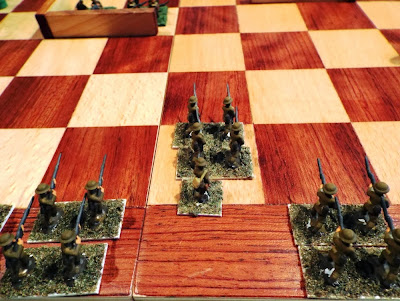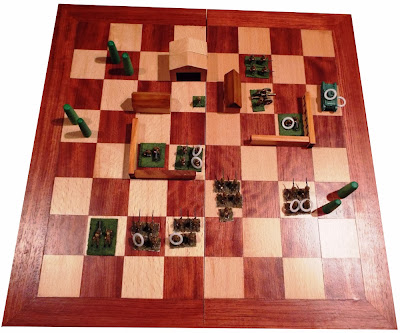The following play-test was somewhat different from the usual ones that I set up because for once I was not using some of my own rules; I was play-testing the latest version of Ross Macfarlane’s 20th Century Square Brigadier rules. As the time available was quite limited – as was the space on my wargames table – I set up a small battle for a farm (MacDonald’s farm!) on my wooden chessboard.
The forces available were also limited. The defenders had:
Turn 1
The two sides threw for initiative. The Defenders won, but chose not to move. The Attackers were able to move one Infantry Unit and their Command Unit forward.
The Defenders fired at the Attackers ... and missed.
Turn 2
The two sides threw for initiative. The Attackers won, and moved three Infantry Units and their Light Tank Unit forward.
The Defenders fired at the advancing enemy. The Field Artillery Unit hit one of the Attacker's Infantry Units and scored a casualty, as did one of the Machine Gun Units and an Infantry Unit.
As the Defenders were not moving, the Attackers now fired ...
... and managed to inflict a casualty on one of the Defender's Infantry Units.
Turn 3
The two sides threw for initiative. The Attackers won, and moved all six of their Units forward.
The Defenders opened fire on the Attackers. The Field Artillery Unit hit and damaged the Attacker's Light Tank Unit and one of the Machine Gun Units inflicted a second casualty on one of the Attacker's Infantry Units. To the left of the Attacker's Command Unit, two of the Attacker's Infantry Units were forced to retreat.
In reply the Attackers returned fire on the non-moving Defenders. Despite being behind cover, one of the Machine Gun Units suffered a casualty as did the foremost of the defender's Infantry Units.
Turn 4
The two sides threw for initiative. The Attackers won, and moved forward their Light Tank Unit and an Infantry Unit (accompanied by the Command Unit).
The Defenders fired at the Light Tank Unit with their Field Artillery Unit and reduced its potency still further.
The Defenders were also able to force the Attacker's Infantry Unit to retreat.
The Attackers now fired at the Defenders, who had chosen – yet again – not to move.
Regrettably their fire was – to put it bluntly – awful, and they inflicted no damage whatsoever upon the Defenders!
At the end of the turn, the overall situation looked like this:
Turn 5
The two sides threw for initiative. The Attackers won, and moved forward their Light Tank Unit, two Infantry Units (including the one accompanied by the Command Unit), and their Machine Gun Unit.
The Defenders fired at the Attackers with devastating results. First the combined fire of the Defender's Field Artillery Unit and their reserve Infantry Unit destroyed the Attacker's Light Tank Unit.
Then one of the Defender's Machine Gun Units inflicted a further casualty on one of the Attacker's Infantry Units ... and wiped it out.
In the centre one of the Defender's Infantry Units inflicted a casualty on the Attacker's Infantry Unit that was accompanied by the Command Unit ...
... and the second of the Defender's Machine Gun Unit inflicted a casualty on yet another of the Attacker's Infantry Units.
At this point the Attacker decided that his attack had failed, and planned to pull his remaining Units back to their start-line. Their losses were mounting, and there was no possibility of victory.
The situation at the end of the battle – and before the retreat – looked like this:
Conclusions
These are a splendid set of wargame rules and are ideally suited for this sort of small action. What I particularly liked is the use of a dice throw to decide which side moves first ... and therefore fires second. This was a deciding factor in this battle and allowed the defenders to disrupt attacks before the attacker could exploit any advantage they might have gained.
I know that Ross Macfarlane is still developing these rules – and their 19th century equivalent – and I look forward to following their continued evolution via his blog.
The forces available were also limited. The defenders had:
- 2 Infantry Units
- 2 Machine Gun Units
- 1 Field Artillery Unit
- 1 Command Unit
- 4 Infantry Units
- 1 Machine Gun Unit
- 1 Light Tank Unit
- 1 Command Unit
Turn 1
The two sides threw for initiative. The Defenders won, but chose not to move. The Attackers were able to move one Infantry Unit and their Command Unit forward.
The Defenders fired at the Attackers ... and missed.
Turn 2
The two sides threw for initiative. The Attackers won, and moved three Infantry Units and their Light Tank Unit forward.
The Defenders fired at the advancing enemy. The Field Artillery Unit hit one of the Attacker's Infantry Units and scored a casualty, as did one of the Machine Gun Units and an Infantry Unit.
As the Defenders were not moving, the Attackers now fired ...
... and managed to inflict a casualty on one of the Defender's Infantry Units.
Turn 3
The two sides threw for initiative. The Attackers won, and moved all six of their Units forward.
The Defenders opened fire on the Attackers. The Field Artillery Unit hit and damaged the Attacker's Light Tank Unit and one of the Machine Gun Units inflicted a second casualty on one of the Attacker's Infantry Units. To the left of the Attacker's Command Unit, two of the Attacker's Infantry Units were forced to retreat.
In reply the Attackers returned fire on the non-moving Defenders. Despite being behind cover, one of the Machine Gun Units suffered a casualty as did the foremost of the defender's Infantry Units.
Turn 4
The two sides threw for initiative. The Attackers won, and moved forward their Light Tank Unit and an Infantry Unit (accompanied by the Command Unit).
The Defenders fired at the Light Tank Unit with their Field Artillery Unit and reduced its potency still further.
The Defenders were also able to force the Attacker's Infantry Unit to retreat.
The Attackers now fired at the Defenders, who had chosen – yet again – not to move.
Regrettably their fire was – to put it bluntly – awful, and they inflicted no damage whatsoever upon the Defenders!
At the end of the turn, the overall situation looked like this:
Turn 5
The two sides threw for initiative. The Attackers won, and moved forward their Light Tank Unit, two Infantry Units (including the one accompanied by the Command Unit), and their Machine Gun Unit.
The Defenders fired at the Attackers with devastating results. First the combined fire of the Defender's Field Artillery Unit and their reserve Infantry Unit destroyed the Attacker's Light Tank Unit.
Then one of the Defender's Machine Gun Units inflicted a further casualty on one of the Attacker's Infantry Units ... and wiped it out.
In the centre one of the Defender's Infantry Units inflicted a casualty on the Attacker's Infantry Unit that was accompanied by the Command Unit ...
... and the second of the Defender's Machine Gun Unit inflicted a casualty on yet another of the Attacker's Infantry Units.
At this point the Attacker decided that his attack had failed, and planned to pull his remaining Units back to their start-line. Their losses were mounting, and there was no possibility of victory.
The situation at the end of the battle – and before the retreat – looked like this:
Conclusions
These are a splendid set of wargame rules and are ideally suited for this sort of small action. What I particularly liked is the use of a dice throw to decide which side moves first ... and therefore fires second. This was a deciding factor in this battle and allowed the defenders to disrupt attacks before the attacker could exploit any advantage they might have gained.
I know that Ross Macfarlane is still developing these rules – and their 19th century equivalent – and I look forward to following their continued evolution via his blog.

















































An enjoyable report. I'm very happy that you tried the rules and that the game went well. It looks like a tough nut for the attackers to crack but a common task to be given.
ReplyDeleteRoss Mac,
ReplyDeleteThe rules worked well, and the battle flowed along nicely and the result was by no means a foregone conclusion. It was a difficult nut to crack ... but not impossible. After all, how many times have small forces been given a big task to achieve?
All the best,
Bob
Stu Rat,
ReplyDeleteI did consider calling it Macfarlane's Farm ... but decided not to.
All the best,
Bob
Bob, looking at the photos that accompanying your report, showing troops on a chessboard, I had a sudden, but off-topic, idea:
ReplyDeleteWhat about having armies that portrayed - more or less - the medieval forces of a chess set fight on the board, but using adaptations of your and Ross's rules?
The King would be rather like a Camp in DBA/HotT; the Queen would revert to its original role of the General/Army Commander, escorted by a bodyguard of noblemen.
Knights would become units of mounted men at arms; pawns, units of infantry, probably a mixture of bill/pike men and archers.
The bishops could be warrior monks like the Templars, or religious leaders/holy relics &c. that would not fight, but could rally/restore the losses of a unit they joined/accompanied.
The rooks would become actaul castles, that would be deployed (ie built) and then remain stationary, controlling ranks and files with their artillery/engines of war, and provide strongholds into which a limited number of units could retreat, and from which they could sally forth when the coast was clear.
Just a thought...
Arthur1815,
ReplyDeleteI can see no reason why your idea would not work ... and it would be a better representation of a medieval battle than chess could ever be.
The playing pieces could be unit bases rather than individual figures, which would make it more like a 'proper' wargame.
An interesting idea ... and one that would certainly merit a magazine article.
All the best,
Bob